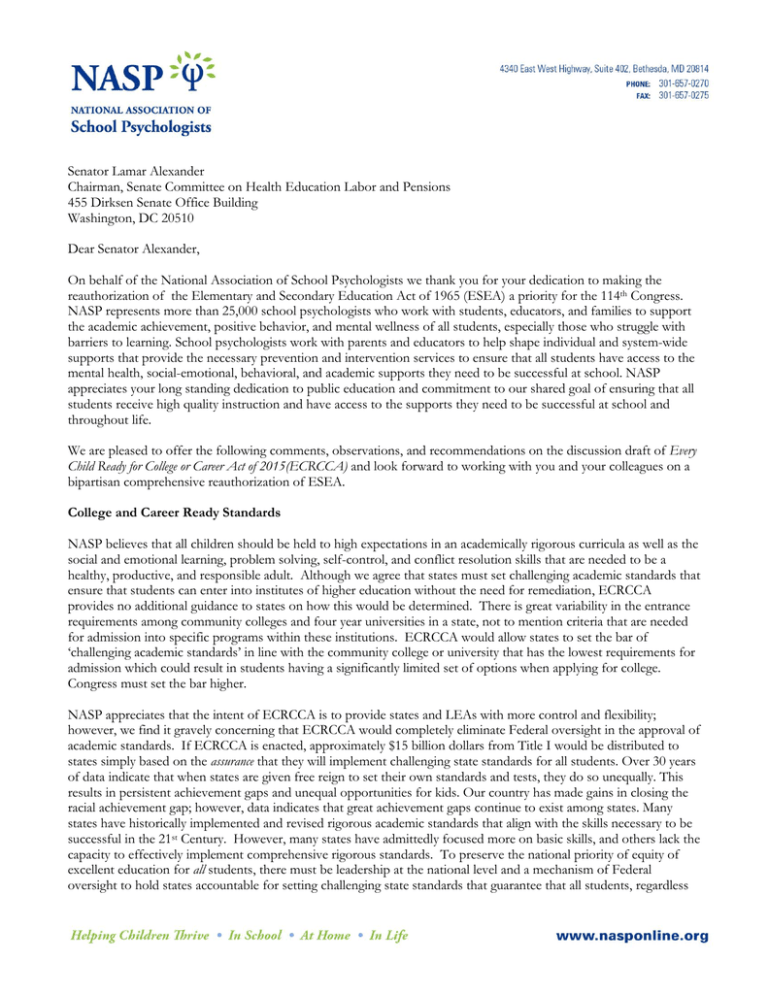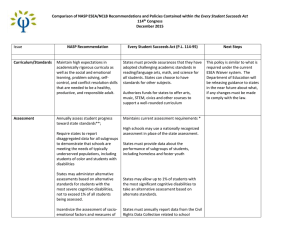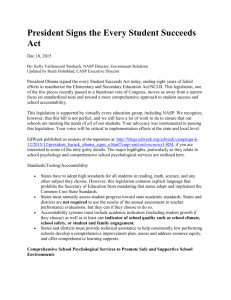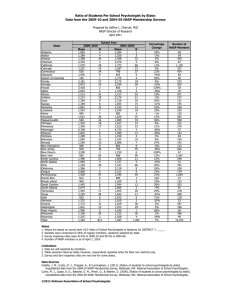Senator Lamar Alexander 455 Dirksen Senate Office Building
advertisement

Senator Lamar Alexander Chairman, Senate Committee on Health Education Labor and Pensions 455 Dirksen Senate Office Building Washington, DC 20510 Dear Senator Alexander, On behalf of the National Association of School Psychologists we thank you for your dedication to making the reauthorization of the Elementary and Secondary Education Act of 1965 (ESEA) a priority for the 114th Congress. NASP represents more than 25,000 school psychologists who work with students, educators, and families to support the academic achievement, positive behavior, and mental wellness of all students, especially those who struggle with barriers to learning. School psychologists work with parents and educators to help shape individual and system-wide supports that provide the necessary prevention and intervention services to ensure that all students have access to the mental health, social-emotional, behavioral, and academic supports they need to be successful at school. NASP appreciates your long standing dedication to public education and commitment to our shared goal of ensuring that all students receive high quality instruction and have access to the supports they need to be successful at school and throughout life. We are pleased to offer the following comments, observations, and recommendations on the discussion draft of Every Child Ready for College or Career Act of 2015(ECRCCA) and look forward to working with you and your colleagues on a bipartisan comprehensive reauthorization of ESEA. College and Career Ready Standards NASP believes that all children should be held to high expectations in an academically rigorous curricula as well as the social and emotional learning, problem solving, self-control, and conflict resolution skills that are needed to be a healthy, productive, and responsible adult. Although we agree that states must set challenging academic standards that ensure that students can enter into institutes of higher education without the need for remediation, ECRCCA provides no additional guidance to states on how this would be determined. There is great variability in the entrance requirements among community colleges and four year universities in a state, not to mention criteria that are needed for admission into specific programs within these institutions. ECRCCA would allow states to set the bar of ‘challenging academic standards’ in line with the community college or university that has the lowest requirements for admission which could result in students having a significantly limited set of options when applying for college. Congress must set the bar higher. NASP appreciates that the intent of ECRCCA is to provide states and LEAs with more control and flexibility; however, we find it gravely concerning that ECRCCA would completely eliminate Federal oversight in the approval of academic standards. If ECRCCA is enacted, approximately $15 billion dollars from Title I would be distributed to states simply based on the assurance that they will implement challenging state standards for all students. Over 30 years of data indicate that when states are given free reign to set their own standards and tests, they do so unequally. This results in persistent achievement gaps and unequal opportunities for kids. Our country has made gains in closing the racial achievement gap; however, data indicates that great achievement gaps continue to exist among states. Many states have historically implemented and revised rigorous academic standards that align with the skills necessary to be successful in the 21st Century. However, many states have admittedly focused more on basic skills, and others lack the capacity to effectively implement comprehensive rigorous standards. To preserve the national priority of equity of excellent education for all students, there must be leadership at the national level and a mechanism of Federal oversight to hold states accountable for setting challenging state standards that guarantee that all students, regardless of state or school district, graduate from high school ready for college and career. We urge you to reinstate the Secretary’s authority to review state plans and approve state standards as a condition of receiving Title I dollars. Assessment and Accountability Systems No Child Left Behind (NCLB) required states, for the first time, to implement complex accountability systems based on standards in reading, math, and science, as a condition for receiving Title I dollars. Despite the flaws and unintended consequences of NCLB, this requirement brought much needed attention to the achievement gaps that existed between specific groups of students, among specific schools, and across states and spurred conversation and action on to close these gaps. Although we have made progress, we have a long way to go. Assessment As school psychologists, we have extensive training and expertise in appropriate assessment systems and effective decision making based on such data. Effective assessment systems produce critical data that allows for inter and intra state comparisons and can be used to inform improved education policy and practice. There is little empirical evidence demonstrating the usefulness of grade span testing; therefore we caution against its use and offer the following recommendations regarding assessment: maintain the current requirement that states test students annually and in math and reading (grades 3-8) and once in high school remain in any law intended to reauthorize ESEA. require states to report disaggregated data for all subgroups to demonstrate that schools are meeting the needs of typically underserved populations, including students of color and students with disabilities. It is for this reason, in part, that there must be an allowance for Federal guidance and oversight of state’s creation and implementation of challenging academic standards. Incentivize the assessment of socio-emotional factors and measures of school climate. There is a wealth of research that highlights the strong relationship among students’ behavioral, social-emotional and mental health, school climate, and academic achievement. Bringing out the best in students and schools requires more than rigorous curriculum and quality instruction. These are central factors in school success, but even the best teachers will face barriers to teaching if the school climate is not supportive and students are not ready and able to learn. The attention that school gives to the climate and culture for learning must be intentional and purposeful and clearly articulated in ESEA. School climate is linked with improved student achievement. Utilizing measures such as standardized test scores, is helpful in tracking gains in academic achievement, but these gains often take time to noticeably improve. Improvements in school climate can signify improved student achievement before the rise in standardized test scores is present. We urge you to require and or/incentivize states and districts receiving Title I funds to explicitly outline how they will measure and address indicators of school climate and other non-academic indicators of school success. Accountability States, districts, and schools have an obligation to demonstrate that their policies and practices are enhancing, not hindering, student learning, growth, and performance. Generally speaking, it is not the assessment that is the problem. The problem lies with the type of assessment given and how schools, districts, and states use the data these assessments generate. The accountability mechanisms put forth in NCLB inappropriately placed too much emphasis on a score obtained on a standardized test, given on one day, and that was intended to capture a year’s worth of learning. Because of the excessively punitive consequences of failing to meet certain accountability requirements, schools and districts significantly narrowed the curriculum to focus solely on what would be tested and a passing score on one test, rather than genuine student learning, became the focus in far too many classrooms. More recently, The Race to the Top Initiative and ESEA Flexibility required states to develop teacher and other personnel evaluation systems of which student performance on high stakes standardized tests was considered a significant factor in determining teacher effectiveness, salary increases, and in some cases, tenure decisions. This only increased focus on attention to improving test scores rather than the process of teaching and learning and led teachers to focus their energy on those struggling students who stood a chance at passing the test (bubble students). High achieving students in need of enrichment and low achieving students who needed significant academic interventions were neglected in favor of achieving a specific pass rate on a single test. Our students deserve better. NASP supports states’ ability to develop their own state assessment system; however, we have concerns with the lack of data that schools are required to collect and report as part of the proposed State Accountability System. ECRCCA would require that state accountability systems measure student achievement in math and reading or language arts and establish a method of differentiating schools based on student achievement, achievement gaps among students, and graduation rates. However, this proposal does not require states to set targeted performance indicators for subgroups and disadvantaged students, not does it require states to outline specific ways it will address schools and districts who are not meeting these targets. Our history and current data show us that complete absence of federal oversight in matters of school and student accountability systems results in inequitable schools and districts that do not ensure that every student has access to a high quality public education. It is not unreasonable, and it should not be viewed as Federal overreach, to require states to set challenging annual and measurable performance targets (of both academic and non-academic indicators) and specify the actions that will be taken when schools and districts are not making meaningful improvement towards these goals. NASP supports SEA and LEA discretion in determining which, if any, additional valid and reliable assessments are administered to students with the intention of providing meaningful data to inform instruction and overall school improvement, but not for ESEA accountability purposes. NASP purports that allowing LEA’s to design and implement their own assessment system to measure student performance with the state’s challenging academic standards would be highly damaging. Very few districts have the capacity to create a valid, reliable, and empirically supported assessment system. There is also no way of ensuring comparability of local assessments across a state. In turn, it is highly unlikely that states would have the capacity to assist LEA’s with this initiative while simultaneously implementing the state run assessment system. Incorporation of Multi-Tier Systems of Support NASP urges you to explicitly include the use of Multi-Tier Systems of Support (MTSS), including positive behavioral interventions and supports and response to intervention, as an allowable use of Title I funds. This will foster the systemic use of best practices that include early identification and intervention that will help students achieve to the best of their potential. Explicitly providing permission for Title I funds to be used for the implementation of MTSS, including professional development for educators, will ensure that resources are targeted to serve struggling students as soon as possible and equip educators with the skills necessary to identify and intervene with students as soon as possible. Inclusion of this language does not imply a programmatic mandate as MTSS can encompass a wide range of curriculum and programs that are tailored to meet the specific needs of individual schools. However, we urge the Committee to include the following definition of MTSS: MULTI-TIERED SYSTEMS OF SUPPORTS. The term ‘multi-tiered system of supports’ means a comprehensive system of differentiated supports that includes these four essential components: A. a school-wide, multi-level instructional and behavioral system for preventing school failure; B. screening; C. progress monitoring; and D. data-based decision making for instruction, movement within the multi-level system, and disability identification (in accordance with state law). The most effective MTSS efforts involve this comprehensive and inclusive approach to helping students who are struggling in meeting academic standards. A specific definition would ensure that schools are using their funds most effectively, using their resources to maximize the impact MTSS can have on student success. Additionally, we recommend that these components be defined so that there is clear alignment between statute and the Department of Education’s federally funded national technical assistance center guiding this evidence-based work. Additionally, we recommend that these components be defined so that there is clear alignment between statute and the Department of Education’s federally funded national technical assistance center guiding this work. School Based Mental Health Providers Access to school-based mental health services directly improves students’ physical and psychological safety, academic performance, and social–emotional learning. Additionally, the most positive outcomes occur when these services are provided by high quality professionals, such as school psychologists, school social workers, and school counselors. These professionals have unique training on how to provide these services within the context of learning. Therefore, we request that the following revision be made to the definition of School-Based Mental Health Services Provider. ‘”SCHOOL-BASED MENTAL HEALTH SERVICES PROVIDER- The term ‘school based mental health services provider’ includes a State licensed or State certified school counselor, school psychologist, school social worker, or other State licensed or certified mental health professional qualified to provide such services to children and adolescents in the school setting.” It is imperative to acknowledge that a specific set of skills is needed to deliver academic, behavioral, social, emotional, and mental health services in a school setting and to require that professionals delivering these services in schools have the appropriate training and qualifications to do so. Additionally, we maintain that all of the professionals included in this definition be defined and we encourage the definition of ‘school psychologist’ as currently defined in current statute, Sec. 5421(e)(4)(A). This definition defines a school psychologist as an individual who: “(A) has completed a minimum of 60 graduate semester hours in school psychology from an institution of higher education and has completed 1,200 clock hours in school psychology, of which 600 hours are in a school setting; “(B) is licensed or certified in school psychology by the State in which the individual works; or “(C) in the absence of such State licensure or certification, possesses national certification by the National School Psychology Certification Board. School psychologists possess a unique set of skills that set us apart from psychologists that practice in the community and it is important that schools and parents understand the distinction. Proposed block grant of Title IV Programs NASP opposes the proposal that would block grant of the currently authorized programs in Title IV. As indicated in the discussion draft, the purpose of this Title is to 1) increase the capacity of schools and communities to create safe, healthy, supportive, and drug-free environments; 2) improve school safety and promote students’ physical and mental health well-being; 3) prevent and reduce substance abuse, school violence, and bullying; and 4) strengthen parent and community engagement to ensure safe, healthy, and supportive school environments. We applaud your recognition of the key relationship between student well-being, school safety, and academic achievement. High quality teachers and effective school principals are certainly critical to student success, but students will not thrive if their physical and psychological needs are not supported in the school environment. We recognize the specific needs of each community may differ, and we appreciate the requirement of a needs assessment to ensure states, school districts, and schools are using these funds to address specific areas in need of improvement. However, no guidance is given to states on what specific indicators must be included in a needs assessment, and we believe far too much flexibility with little accountability is given to states and districts in using these critical funds. The consolidation and elimination of these vital programs will result in the unintended consequence of preventing children from having access to a diverse range of supports necessary to succeed. State and school districts are often forced to make tough budgetary decisions, and far too often, programs and services to support the physical and psychological well- being of students, reduce school violence and improve overall school safety are the first to be cut. Converting Title IV into a block grant will result in a competition among programs and priorities that ultimately will decrease services to children. No school district should have to choose between offering professional development in emergency preparedness and crisis response and improving the availability of school mental health services. Federal investment in dedicated funding streams for programs such as the Elementary and Secondary School Counseling Program, Safe and Drug Free Schools and Communities, and the Carol M. White Physical Education Program have ensured many schools do not have to make this difficult decision. NASP supports the explicit reauthorization of these critical programs; however, we recognize the importance of compromise given the current political and fiscal reality. Therefore, in absence if explicit programmatic reauthorization, we urge you to follow the bipartisan intentions of the 112th Congressional HELP Committee, and the the 113th Congressional HELP Committee and set specific allocations for drug and violence prevention, programs to promote mental health, and programs to promote physical education, fitness, and nutrition. We ask that the specific priorities of the consolidated grant programs be maintained by defining key elements of programs intended to address physical health, mental health, and address drug use and violence prevention. We also encourage you include data collection and reporting on indicators of school safety (including bullying and harassment), school climate, physical health, mental health, rates of suspension and expulsion, as well data regarding the student to staff ratio of school counselors, school psychologists, school social workers (key component of ESSCP) as part of the state required needs assessment. Lastly, we ask that you require states to maintain the following allocations when awarding subgrants from this Title to LEAs: for the aggregate of all subgrants, no less than 20% of funds is to be designated for drug and violence prevention, not less than 20% of funds for programs to promote mental health, and not less than 20% of funds for programs to promote physical activity, education, fitness, and nutrition. We appreciate the difficulty of balancing state and local flexibility with federal priorities and mandates. However, we believe that allocating a specific set aside for the aforementioned priorities does promote state flexibility, while still preserving specific priorities and ensuring states are helping districts provide a wide range of support services necessary for student success. Thank you for your consideration of our recommendations. We look forward to working with you toward a comprehensive reauthorization of the Elementary and Secondary Education Act. Additional questions can be sent to Kelly Vaillancourt, Director of Government Relations (kvaillancourt@naspweb.org). Sincerely, Susan Gorin, CAE Executive Director



